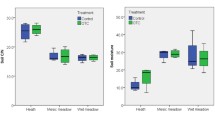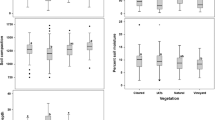Abstract
An experiment was conducted to measure the effects of summer warming on the total population densities of soil-dwelling microarthropods in the high Arctic and to compare these results with those from natural between-year and between-site variations. Small polythene tents were used to elevate summer temperatures over 3 years on polar semi-desert and tundra heath in West Spitsbergen, Svalbard, Norway. Soil cores were taken at regular intervals from tented and untented (control) plots and heat extracted for mites (Acarina: Oribatida) and springtails (Collembola). Species present were similar at both sites, but at the start of the experiment total springtail populations were greater at the polar semi-desert whilst oribatid mite densities were equal at both sites. No significant effect of temperature elevation on oribatid mite populations emerged, even after 3 years. By contrast, springtail numbers were significantly lower on tented versus control plots at the polar semi-desert at the end of year 3, but not so at the tundra heath. Collembola numbers declined at both sites during the warm dry midsummers of 1992/1993 and this was most marked at the better drained polar semi-desert site. Over the equivalent period total oribatid mite populations, while relatively more stable, increased significantly at the polar semi-desert as a result of an increase in the number of juveniles. Results are interpreted in the context of the ecophysiological adaptations of oribatid mites and springtails to soil temperature and moisture. The resulting survival characteristics are considered in relation to the temperature and moisture characteristics of the two sites. The experiment demonstrated that year to year variation in climate, interacting with physical differences between sites, produced an equal or greater effect on microarthropod numbers at any one site than the 8–10% increase in “heat availability” (day degrees above zero) resulting from the summer tent treatment. The limitations of the use of tents to elevate soil temperatures are discussed. Comparisons are made with microarthropod population data from other polar and alpine sites.
Similar content being viewed by others
References
Addison JA (1977) Population dynamics and biology of Collembola on Truelove Lowland. In: Bliss LC (ed) Truelove Lowland, Devon Island, Canada: a high arctic ecosystem. University of Alberta Press, Edmonton, pp 363–382
Addison JA (1981) Biology ofHypogastrura tullbergi (Collembola) at a high arctic site. Holarct Ecol 4:49–58
Bengtson S-A, Fjellberg A, Solhöy T (1974) Abundance of tundra arthropods in Spitsbergen. Entomol Scand 5:137–142
Block W (1982) The Signy Island terrestrial reference sites: XIV. Population studies on the Collembola. Br Antarct Surv Bull 55:33–49
Block W, Webb NR, Coulson SJ, Hodkinson ID (1994) Thermal adaptation in a high arctic collembolanOnychiurus arcticus (Tullberg). J Insect Physiol 40:715–722
Callaghan TV, Sonesson M, Sömme L (1992) Response of terrestrial plants and invertebrates to environmental change at high latitudes. Philos Trans R Soc London Ser B 338:279–288
Chapin FS, Jeffries RL, Reynolds JF, Shaver GR, Svoboda J (eds) (1992) Arctic ecosystems in a changing climate. An ecophysiological perspective. Academic Press, London
Coulson S, Hodkinson ID, Strathdee AT, Bale JS, Block W, Worland MR, Webb NR (1993) Simulated climate change: the interaction between vegetation type and microhabitat temperatures at Ny Ålesund, Svalbard. Polar Biol 13:67–70
Danks HV (1981) Bibliography of the arctic arthropods of the Nearctic region. Entomological Society of Canada, Ottawa
Danks HV (1992) Arctic insects as indicators of environmental change. Arctic 45:159–166
Fjellberg A (1975) Organization and dynamics of Collembola populations on Hardangervidda. In: Wigolaski FE (ed) Ecological studies, analysis and synthesis. Fennoscandian tundra ecosystems part 2. Springer, Berlin Heidelberg New York, pp 73–79
Goddard DG (1979) The Signy Island terrestrial reference sites: Xl. Population studies on the Acari. Br Antarct Surv Bull 48:71–92
Hammer M (1944) Studies on the oribatids and collemboles of Greenland. Medd Groen 141:1–210
Hinz W (1976) Zur Ökologie der Tundra Zentralspitsbergen. Skr Nor Polarinst 163:1–47
Hodkinson ID, Coulson SJ, Webb NR, Block W, Strathdee AT, Bale JS (1994a) Feeding studies onOnychiurus arcticus (Tullberg) (Collembola: Onychiuridae) on West Spitsbergen. Polar Biol 14:17–19
Hodkinson ID, Healey V, Coulson S (1994b) Moisture relationships of the high arctic collembolanOnychiurus arcticus. Physiol Entomol 19:109–114
Kareiva PM, Kingsolver JG, Huey RB (eds) (1993) Biotic interactions and global change. Sinauer, Sunderland
Karppinen E (1967) Data on the oribatids (Acari) of Spitsbergen. Suom Hyönt Aikak 33:18–26
MacLean SF (1981) Introduction: invertebrates. In: Bliss LC, Heal OW, Moore JJ (eds) Tundra ecosystems: a comparative analysis. Cambridge University Press, Cambridge, pp 509–516
Mitchell JFB, Manebe S, Meleshko V, Tokioka T (1990) Equilibrium climate change and its implications for the future. In: Houghton JT, Jenkins GJ, Ephraums JJ (eds) Climate change, the IPCC Scientific Assessment. Cambridge University Press, Cambridge, pp 283–310
Petersen H, Luxton M (1982) A comparative analysis of soil fauna populations and their role in decomposition processes. Oikos 39:288–388
Sendstad E (1976) Notes on the Collembola communities in some major plant associations at Spitsbergen, Svalbard. Norw J Entomol 23:143–148
Sendstad E (1981) Soil ecology of a lichen heath at Spitsbergen, Svalbard: effects of artificial removal of the lichen plant cover. J Range Manage 34:442–445
Seniczak S, Plichta W (1978) Structural dependence of moss mite populations (Acari, Oribatei) on patchiness of vegetation in moss-lichen-tundra at the north coast of Hornsund, West Spitsbergen. Pedobiologia 18:145–152
Stach J (1962) On the fauna of Collembola from Spitsbergen. Acta Zool Cracov 7:1–20
Strathdee AT, Bale JS, Block W, Webb NR, Hodkinson ID, Coulson SJ (1993a) Extreme adaptive polymorphism in a high arctic aphidAcyrthosiphon svalbardicum. Ecol Entomol 18:254–258
Strathdee AT, Bale JS, Block W, Coulson SJ, Hodkinson ID, Webb NR (1993b) The effects of temperature elevation on a field population of the aphidAcyrthosiphon svalbardicum. Oecologia 96:457–465
Thor S (1930) Beiträge zur Kenntnis der invertebraten Fauna von Svalbard. Skr Svalbard Ishavet 27:1–156
Valpas A (1967) Collemboles of Spitsbergen. Suom Hyönt Aikak 33:28–40
Wookey PA, Parsons AN, Welker JM, Potter JA, Callaghan TV, Lee JA, Press MC (1993) Comparative responses of phenology and reproductive development to simulated environmental change in sub-arctic and high arctic plants. Oikos 67:490–502
Wüthrich C (1989) Die Bodenfauna in der arktischen Umwelt des Kongsfjords (Spitzbergen) — Versuch einer integrativen Betrachtung eines Ökosystems. Mater Physiogeogr Basel 12:1–133
Author information
Authors and Affiliations
Rights and permissions
About this article
Cite this article
Coulson, S.J., Hodkinson, I.D., Wooley, C. et al. Effects of experimental temperature elevation on high-arctic soil microarthropod populations. Polar Biol 16, 147–153 (1996). https://doi.org/10.1007/BF02390435
Received:
Accepted:
Issue Date:
DOI: https://doi.org/10.1007/BF02390435




